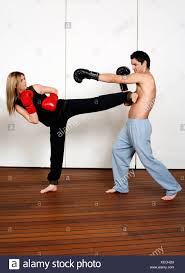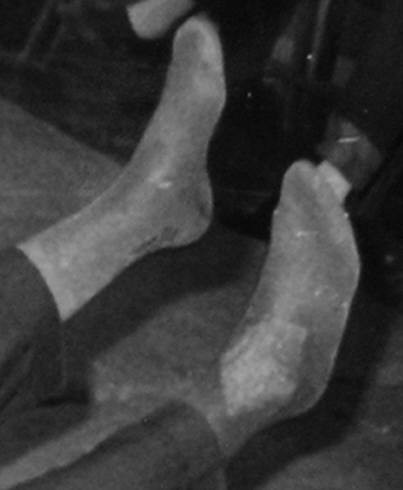I would say that strategies are the things you need a teacher to show you.
what are the wing chun strategies you show your students?
Follow along with the video below to see how to install our site as a web app on your home screen.
Note: This feature may not be available in some browsers.
I would say that strategies are the things you need a teacher to show you.
well mr wang i suppose my arms would just stay gaurding my chest and i would cop a kick to the gut and vomit blood everywhere and look oh so silly.What if your opponent kicks at your belly. His leg is longer than your arm. Your punch can't reach him, but his kick can reach you. If you always have to protect your chest, your opponent has put you in defense mode. IMO, that's not good.
With your "full upper body" exposed to your opponent's kick, it's very difficult for him to miss his kick.

It's trade off.well mr wang i suppose my arms would just stay gaurding my chest and i would cop a kick to the gut and vomit blood everywhere and look oh so silly.
arnt we past this? your arms can move as can your feet. you use the training from your given style to evade, block, counter etc. any static positiosodide facing or not is vulnerable if you dont move .
what i was getting at is that these fighting styles dont stand in the positions they do for no reason. side facing arts do it for the reasons you mentioned. wing chun typically (not exclusively) faces square because it facilitates other techniques and principles within the style.
thank youIt's trade off.
Square stance:
PRO: Both arms have the same reach.
CON. Expose your center. Your chest is exposed to the front kick. Your arm don't have the maximum reach. Your balance is weak front and back.
Side stance:
PRO: You have minimum exposed area. You have maximum reach.
CON: You have 1 long arm and 1 short arm. The back hand has to travel far distance to hit opponent. Your chest is exposed to roundhouse kick. Your balance is weak sideway.
What if your opponent kicks at your belly. His leg is longer than your arm. Your punch can't reach him, but his kick can reach you. If you always have to protect your chest, your opponent has put you in defense mode. IMO, that's not good.
With your "full upper body" exposed to your opponent's kick, it's very difficult for him to miss his kick.
It's trade off.
Square stance:
PRO: Both arms have the same reach.
CON. Expose your center. Your chest is exposed to the front kick. Your arm don't have the maximum reach. Your balance is weak front and back.
Side stance:
PRO: You have minimum exposed area. You have maximum reach.
CON: You have 1 long arm and 1 short arm. The back hand has to travel far distance to hit opponent. Your chest is exposed to roundhouse kick. Your balance is weak sideway.
While he really knew every throw and skill he said he really only knew 5 throws . He just knew every variation of those 5 everything else was just window dressing. Overall that is the key to fighting. You don't need to know a lot but what you know you should know all the ins and out.
What if your opponent kicks at your belly
I can't think of a single system I've ever seen that doesn't include some drills (whether for conditioning, or for some other purpose) that don't quite look like their fighting. I don't know how you'd avoid that and still be efficient. I mean, you don't fight with a single-head in your hands. I don't fight with a kettlebell in mine (sparring partners tend to object).Do you think it's a reasonable question to ask
- Why don't you fight the same way as you train?
- You have a long range tool in your toolbox but you are not using it. Why?
Why should I invest the time in figuring out what not to train on a given side?Do you train a set of techniques on your right side, and a different set of techniques on your left side? If you do, you train for fighting.
My teacher had a mark on his right foot, but nothing on his left foot. There are certain techniques that he only trained on his right foot but not on his left foot. A good example that he trained for fighting.
Most people who trains for health will train evenly on both sides.

I would argue that if the students have to find it themselves, it's not actually being taught. Each successive generation is havinng to rediscover it, which isn't very systematic.I agree that we need to test our skill, but I also think there's more to the strategies contained within the WC system than what most of us (as a group) have interpreted.
Are they discovering, or are they trying to innovate new ways to compensate for what isn't there?I would argue that if the students have to find it themselves, it's not actually being taught. Each successive generation is havinng to rediscover it, which isn't very systematic.
If it's not taught, the two amount to the same thing.Are they discovering, or are they trying to innovate new ways to compensate for what isn't there?
I know what the answer was for me.
I would argue that if the students have to find it themselves, it's not actually being taught. Each successive generation is havinng to rediscover it, which isn't very systematic.
That's a difference in application of a given technique. That's not strategy, though your difference in size could also lead to a different preferred strategy (as could disposition, leg speed, etc.). Still, if the students are left to find it themselves, it's not taught. If it's not taught, I'd argue it's not actually in the system (though that doesn't mean it doesn't fit within the system).I dunno I think it might come down to the artistic expression of violence. The art in martial art, maybe.
If you take a single technique from any form and you analyse how to apply it inside, outside, over and under etc. Me as a tallish guy who enjoys getting close has a preference for over and inside, but then a shortish guy who is defensive is likely to apply the same technique under and outside. That's his attack preference (or artistic expression) from his build and mindset, a teacher can't teach the best way that person should adopt the technique that's down to what feels right to them... and that's what each student needs to discover.
As my old sifu used to say "take what works for you. You can't take everything from the Wing Chun supermarket."
That's a difference in application of a given technique. That's not strategy, though your difference in size could also lead to a different preferred strategy (as could disposition, leg speed, etc.). Still, if the students are left to find it themselves, it's not taught. If it's not taught, I'd argue it's not actually in the system (though that doesn't mean it doesn't fit within the system).
I said "difference in application". Meaning, you're applying it differently.Your completely entitled to your view and I respect it, but for me, I disagree. To me it seems that your saying that each time an opponent moves left or right or sinks and rises and I use a man sau to bridge, for example, your saying its a different application. In my view the application is the intent of the technique, If the intent is the same its the same application.
Further, I kinda disagree with the concept of "if my sifu, sensai didnt teach it its not in the system." Wing Chun already has oodles and oodles of that... and there is already a huge discrepancy between wing chun lineages and schools of how to apply and perform techniques.... such an approach has lead to a bit of a connundrum in that if you have two sifus in two different schools on the same road and one teaches one application and the other a different one of the same technique which is the application in the system... unfortunately, in wing chun circles you see a lot of this and then some folks start saying my sifu didn't teach me that so your approach is wrong... etc etc.
Just my view and its a big world so we all are entitled to different ones.
Well, then there is this thing called FOOTWORK
I think it depends on how the system is being defined. Seems to me that a lot of people define the system by the body of techniques. I don’t think that’s the best way. I think a better way is to define the principles, with a body of techniques that help illustrate how the principles are put to use. That leaves the door wide open to have room for any technique, as long as it can fit within the principles. I like to say: even something that isn’t a “proper” technique at all can find a place within the system as an individual may use it.I said "difference in application". Meaning, you're applying it differently.
If it's not taught, then the student didn't get it from the system. If I figure out how to throw a hook, but was never taught a hook by the people I studied with, then the hook was not within the system as they delivered it. Doesn't mean it can't fit (I learned one elsewhere, decided it fit, and put it into the version I teach). I don't see how you can argue something exists within the system as taught by the instructor, if the instructor isn't teaching it. It rather definitively isn't in what they taught.
That's not to say it doesn't BELONG in there. Nor that it can't be in someone else's version (see my reference to the hook, above). But it wasn't in what that instructor taught.
